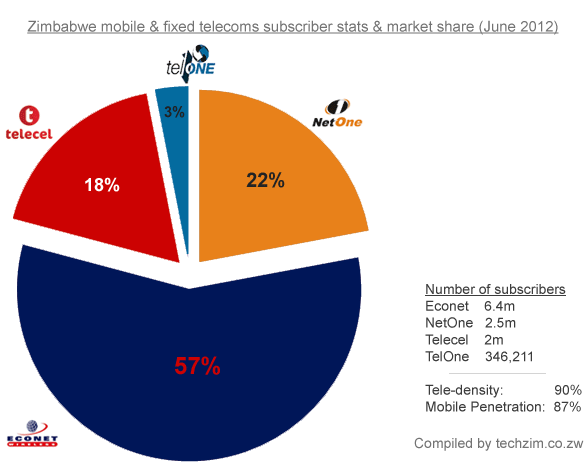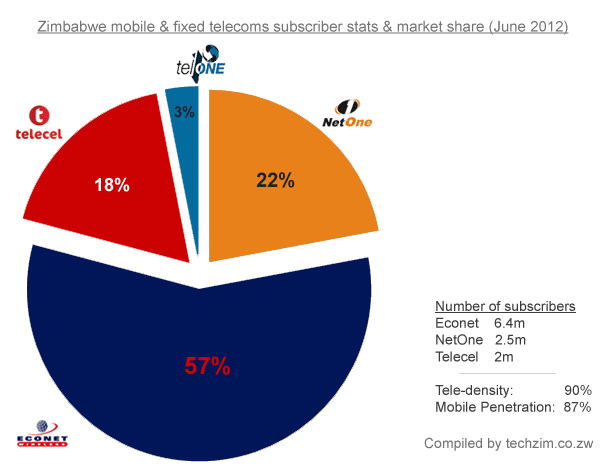Zimbabwe’s telecommunications regulator, POTRAZ, has released the June 2012 (2nd quarter) mobile phone and fixed line subscribers statistics. The stats, which were published in the state owned daily, The Herald, today, show that Zimbabwe’s tele-density increased from 81.5% in the year’s first quarter to 89.9% in the second quarter. This is a significant jump and is testament to the rapid adoption of mobile phones by Zimbabweans in the past year. Consider that in June 2011, the country’s tele-density was just 56.6%!

On to the stats, the subscriber numbers released are for the 3 GSM mobile operators, Econet, NetOne & Telecel, and Zimbabwe’s sole fixed line operator, TelOne. According to the stats, Zimbabwe had 10,914,770 active mobile subscribers and 346,211 active fixed lines in the second quarter. The mobile subscribers are split as follows:
Econet – 6,427,788
NetOne – 2,484,342
Telecel – 2,002,640
Zimbabwe’s population estimate is 12.5 million, and the mobile penetration according to these figures is therefore 87.2%.
You will notice that in terms of growth, as compared to the March 2012 stats, NetOne grew its subscriber base the most adding a massive 884,342 subscribers. Of the 3 GSM mobile operators, Econet grew the least, only adding 27,788 subscribers. Telecel’s growth was mediocre with just 169,862 subscribers added to their 1,832,778 March 2012 figure. TelOne, worryingly, lost 26,789 subscribers in the period.
The stats reveal that Telecel has, once again (or for the third time depending on who you ask), lost the second position to the state run mobile operator, NetOne.
Econet’s addition of just 27,888 subscribers in 3 months is even more disappointing. According to these stats the company lost 6.2% subscriber market share in that period as it now only accounts for 58.9% of Zimbabwe’s active SIM cards. Down from 65.1% in March 2012. This must be worrying for them as it seems the 2 cents savings on on-net calls that subscribers are likely to make on calls to Econet’s massive subscriber base is not attracting subscribers.
As you may be aware however, both Telecel and Econet announced to the press, their current stats last week. Current here is assumed to be end of August at least. Telecel said it has hit 2.2 million subscribers and Econet claimed 7 million.

4 comments
How do the companies account for subscribers with multiple lines? Does these stats mean that 89.9% of Zim population is now connected? Can this data be used by business to determine the penetration of communication devices in the Zim population.
– How do the companies account for subscribers with multiple lines? Each company reports its own, so yes some (even most) subscribers may be active on more than one network.
– Does these stats mean that 89.9% of Zim population is now connected? No. The mobile penetration is linked to the population quite loosely. Would mean that if we had just one mobile operator.
– Can this data be used by business to determine the penetration of communication devices in the Zim population? Yes. and No. some devices are 2 SIM and 3 SIM devices are starting to appear on the market as well.
Imagine 7 year olds and below having a phone, would they do anything meaningful with the phone? maybe recieve and call parents but its such distractive gadget for them. I would estimate that the population of people who are under 7 years and below is about 15%. If Zimbabwe’s Teledensity is now 90%, That means all people who are 7 years and above have got a phone and some even double.
In general, one would take these figures with a pinch of salt because there is a lot of people with even tripple lines. Also most of that data produced by these mobile operators even to POTRAZ is for marketing than reality because most of those lines are redundant anyway. Personally I think the true Teledensity lies somewhere in the 60 to 70% region.
A country’s tele-density measures the number of active mobile phone SIM cards and landlines as a percentage of the country’s total population.